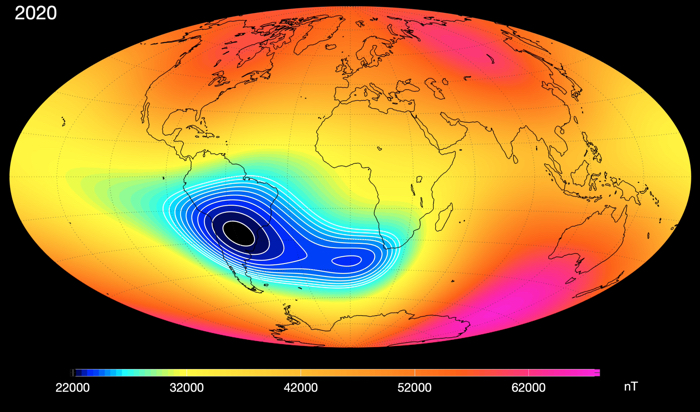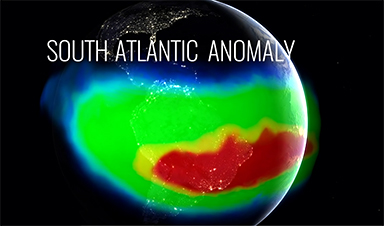NASA is actively monitoring a strange anomaly in Earth’s magnetic field: a giant region of lower magnetic intensity in the skies above the planet, stretching out between South America and southwest Africa.
The space agency’s satellites and spacecraft are particularly vulnerable to the weakened magnetic field strength within the anomaly, and the resulting exposure to charged particles from the Sun.
The South Atlantic Anomaly (SAA) – likened by NASA to a ‘dent’ in Earth’s magnetic field, or a kind of ‘pothole in space’ – generally doesn’t affect life on Earth, but the same can’t be said for orbital spacecraft (including the International Space Station), which pass directly through the anomaly as they loop around the planet at low-Earth orbit altitudes.
During these encounters, the reduced magnetic field strength inside the anomaly means technological systems onboard satellites can short-circuit and malfunction if they become struck by high-energy protons emanating from the Sun.
These random hits may usually only produce low-level glitches, but they do carry the risk of causing significant data loss, or even permanent damage to key components – threats obliging satellite operators to routinely shut down spacecraft systems before spacecraft enter the anomaly zone.
Mitigating those hazards in space is one reason NASA is tracking the SAA; another is that the mystery of the anomaly represents a great opportunity to investigate a complex and difficult-to-understand phenomenon, and NASA’s broad resources and research groups are uniquely well-appointed to study the occurrence.
The primary source is considered to be a swirling ocean of molten iron inside Earth’s outer core, thousands of kilometers below the ground. The movement of that mass generates electrical currents that create Earth’s magnetic field, but not necessarily uniformly, it seems.
A huge reservoir of dense rock called the African Large Low Shear Velocity Province, located about 2,900 kilometers (1,800 miles) below the African continent, disturbs the field’s generation, resulting in the dramatic weakening effect – which is aided by the tilt of the planet’s magnetic axis.
“The observed SAA can be also interpreted as a consequence of weakening dominance of the dipole field in the region,” said NASA Goddard geophysicist and mathematician Weijia Kuang in 2020.

While there’s much scientists still don’t fully understand about the anomaly and its implications, new insights are continually shedding light on this strange phenomenon.
For example, one study led by NASA heliophysicist Ashley Greeley in 2016 revealed the SAA is drifting slowly in a north-westerly direction.
It’s not just moving, however. Even more remarkably, the phenomenon seems to be in the process of splitting in two, with researchers in 2020 discovering that the SAA appeared to be dividing into two distinct cells, each representing a separate center of minimum magnetic intensity within the greater anomaly.
A study published in July 2020 suggested the phenomenon is not a freak event of recent times, but a recurrent magnetic event that may have affected Earth since as far back as 11 million years ago.
If so, that could signal that the South Atlantic Anomaly is not a trigger or precursor to the entire planet’s magnetic field flipping, which is something that actually happens, if not for hundreds of thousands of years at a time.
Obviously, huge questions remain, but with so much going on with this vast magnetic oddity, it’s good to know the world’s most powerful space agency is watching it as closely as they are.
“Even though the SAA is slow-moving, it is going through some change in morphology, so it’s also important that we keep observing it by having continued missions,” said Sabaka.
“Because that’s what helps us make models and predictions.”
News
AI Helped Scientists Stop a Virus With One Tiny Change
Using AI, researchers identified one tiny molecular interaction that viruses need to infect cells. Disrupting it stopped the virus before infection could begin. Washington State University scientists have uncovered a method to interfere with a key [...]
Deadly Hospital Fungus May Finally Have a Weakness
A deadly, drug-resistant hospital fungus may finally have a weakness—and scientists think they’ve found it. Researchers have identified a genetic process that could open the door to new treatments for a dangerous fungal infection [...]
Fever-Proof Bird Flu Variant Could Fuel the Next Pandemic
Bird flu viruses present a significant risk to humans because they can continue replicating at temperatures higher than a typical fever. Fever is one of the body’s main tools for slowing or stopping viral [...]
What could the future of nanoscience look like?
Society has a lot to thank for nanoscience. From improved health monitoring to reducing the size of electronics, scientists’ ability to delve deeper and better understand chemistry at the nanoscale has opened up numerous [...]
Scientists Melt Cancer’s Hidden “Power Hubs” and Stop Tumor Growth
Researchers discovered that in a rare kidney cancer, RNA builds droplet-like hubs that act as growth control centers inside tumor cells. By engineering a molecular switch to dissolve these hubs, they were able to halt cancer [...]
Platelet-inspired nanoparticles could improve treatment of inflammatory diseases
Scientists have developed platelet-inspired nanoparticles that deliver anti-inflammatory drugs directly to brain-computer interface implants, doubling their effectiveness. Scientists have found a way to improve the performance of brain-computer interface (BCI) electrodes by delivering anti-inflammatory drugs directly [...]
After 150 years, a new chapter in cancer therapy is finally beginning
For decades, researchers have been looking for ways to destroy cancer cells in a targeted manner without further weakening the body. But for many patients whose immune system is severely impaired by chemotherapy or radiation, [...]
Older chemical libraries show promise for fighting resistant strains of COVID-19 virus
SARS‑CoV‑2, the virus that causes COVID-19, continues to mutate, with some newer strains becoming less responsive to current antiviral treatments like Paxlovid. Now, University of California San Diego scientists and an international team of [...]
Lower doses of immunotherapy for skin cancer give better results, study suggests
According to a new study, lower doses of approved immunotherapy for malignant melanoma can give better results against tumors, while reducing side effects. This is reported by researchers at Karolinska Institutet in the Journal of the National [...]
Researchers highlight five pathways through which microplastics can harm the brain
Microplastics could be fueling neurodegenerative diseases like Alzheimer's and Parkinson's, with a new study highlighting five ways microplastics can trigger inflammation and damage in the brain. More than 57 million people live with dementia, [...]
Tiny Metal Nanodots Obliterate Cancer Cells While Largely Sparing Healthy Tissue
Scientists have developed tiny metal-oxide particles that push cancer cells past their stress limits while sparing healthy tissue. An international team led by RMIT University has developed tiny particles called nanodots, crafted from a metallic compound, [...]
Gold Nanoclusters Could Supercharge Quantum Computers
Researchers found that gold “super atoms” can behave like the atoms in top-tier quantum systems—only far easier to scale. These tiny clusters can be customized at the molecular level, offering a powerful, tunable foundation [...]
A single shot of HPV vaccine may be enough to fight cervical cancer, study finds
WASHINGTON -- A single HPV vaccination appears just as effective as two doses at preventing the viral infection that causes cervical cancer, researchers reported Wednesday. HPV, or human papillomavirus, is very common and spread [...]
New technique overcomes technological barrier in 3D brain imaging
Scientists at the Swiss Light Source SLS have succeeded in mapping a piece of brain tissue in 3D at unprecedented resolution using X-rays, non-destructively. The breakthrough overcomes a long-standing technological barrier that had limited [...]
Scientists Uncover Hidden Blood Pattern in Long COVID
Researchers found persistent microclot and NET structures in Long COVID blood that may explain long-lasting symptoms. Researchers examining Long COVID have identified a structural connection between circulating microclots and neutrophil extracellular traps (NETs). The [...]
This Cellular Trick Helps Cancer Spread, but Could Also Stop It
Groups of normal cbiells can sense far into their surroundings, helping explain cancer cell migration. Understanding this ability could lead to new ways to limit tumor spread. The tale of the princess and the [...]





















